Complete a review assignment
In a collaborative review, you use the link in the email notification you receive to open the content in Inspire's editor. The editor is a web-based application that includes an XML tool where you’ll review content. By default Inspire hides XML tags and markup unless you explicitly choose an option to show it. Otherwise you can complete your review using a friendly interface for adding comments and tracking changes without seeing complex XML markup.
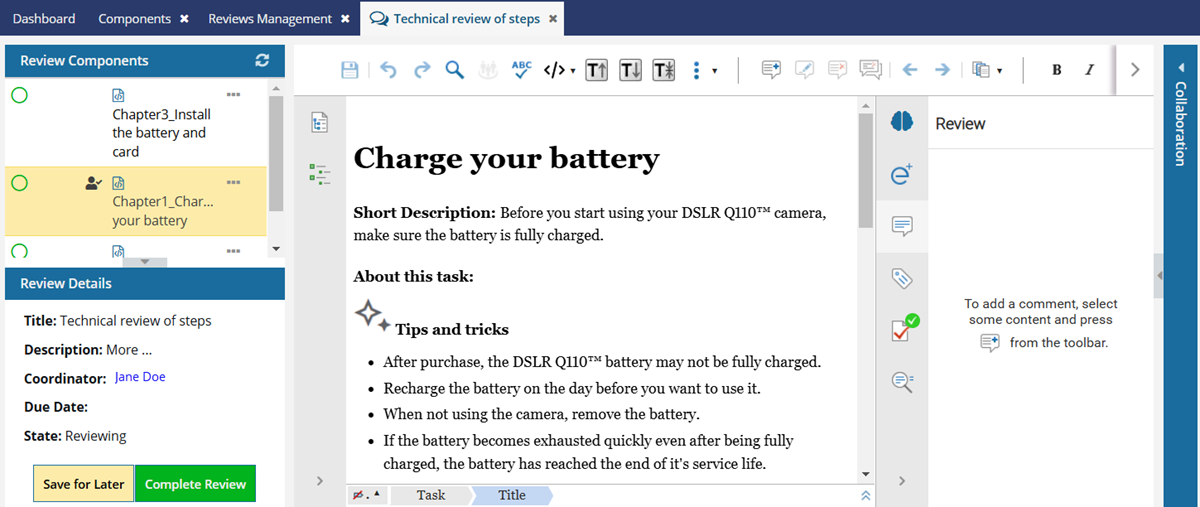
When working with a review assignment, you can:
- Manage your to-do list
- Keep track of deadlines
- Comment and change text
- Chat with the other reviewers
- Add map topics to a review
- Complete an assignment
- Receive notifications


Manage your to-do list
In the Review Components pane, you can see a list of components you've been asked to review. From this list you can select a component to open in the Editor pane.
 You can track your progress through the list of review components using the green circle next to the component name. You can fill in the circle to mark a component as done when you complete it. Keep in mind this is for your own reference. To let the coordinator know you're done and submit your changes, you'll still need to use the Complete Review button.
You can track your progress through the list of review components using the green circle next to the component name. You can fill in the circle to mark a component as done when you complete it. Keep in mind this is for your own reference. To let the coordinator know you're done and submit your changes, you'll still need to use the Complete Review button.
 Don't see a green circle? Sometimes a review coordinator doesn't want you to edit a component but includes it to help you understand the context of what you're reviewing. In this case, the file is read-only and you can't make any changes to the text, so tracking your progress isn't necessary.
Don't see a green circle? Sometimes a review coordinator doesn't want you to edit a component but includes it to help you understand the context of what you're reviewing. In this case, the file is read-only and you can't make any changes to the text, so tracking your progress isn't necessary.
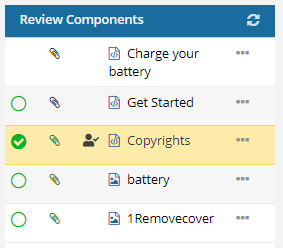
In the Review Components pane, you can also see:
- If a component is Context Only and can't be commented on or edited by looking for a component that doesn't have a green circle.
- If a component has an attachment (
 Black paper clip) or is an attachment (
Black paper clip) or is an attachment ( Green paper clip) by looking for a paper clip icon.
Green paper clip) by looking for a paper clip icon. - If a component is checked out to you (
 ) or someone else by looking for a user icon.
) or someone else by looking for a user icon. - If the component is a topic (
 ) or an image (
) or an image ( ) by looking at the icon before the component name.
) by looking at the icon before the component name.
In the Review Components pane, you can use the  Options menu to check in a file, or request that a checked-out file is checked back in.
Options menu to check in a file, or request that a checked-out file is checked back in.
In the Review Details panel, you can see:
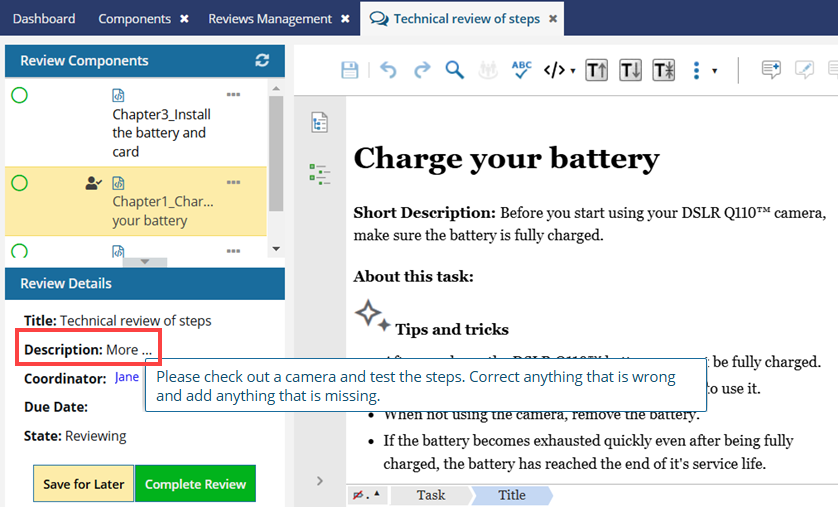
- The review's Title
- The context of the review and read additional instructions. The review coordinator can include instructions and context for reviewers in the Description field when they create the review.
- You can also see the Description on the Dashboard screen in the My Reviews section.
- The text will truncate if it doesn't fit but you can select More... in the Description to see the complete text.
- The user who is the Review Coordinator and you can click on their name to send them email
- The date when you must complete the review by in Due Date
- The State of the review: Reviewing (can edit), Completed (can't edit), Cancelled (can't edit)
In the center pane you can review the content.
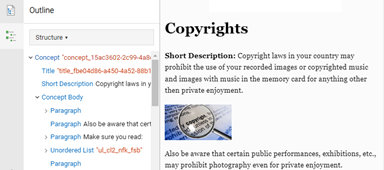
In the right panel, you can see:
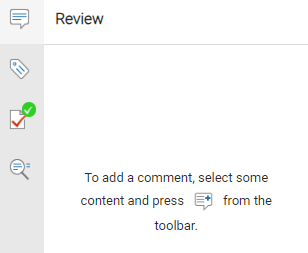
 Review details such as comments and changes made by other reviewers, as well as their email address.
Review details such as comments and changes made by other reviewers, as well as their email address. Attribute details for elements you select in the center pane
Attribute details for elements you select in the center pane If your XML content is valid according to your framework
If your XML content is valid according to your framework Search tools
Search tools

 If you start on a review but need to stop before it's done and finish it later, you can:
If you start on a review but need to stop before it's done and finish it later, you can:
- Save your changes
 .
. - Do one of the following:
- Close the tab

- Click Save for Later

- Close the tab

 Saving your changes and closing the review doesn't update the progress shown for the review on the Dashboard or the Review Management tab. This percent only changes when an entire task in the review is completed, such as when you click Complete Review.
Saving your changes and closing the review doesn't update the progress shown for the review on the Dashboard or the Review Management tab. This percent only changes when an entire task in the review is completed, such as when you click Complete Review.

![]() All reviewers can access a component at the same time. This means you may see a Refresh button next to the component name in this pane when another reviewer makes changes or adds comments. Use Refresh to view current changes or comments for the component.
All reviewers can access a component at the same time. This means you may see a Refresh button next to the component name in this pane when another reviewer makes changes or adds comments. Use Refresh to view current changes or comments for the component.
Keep track of deadlines
Make sure you get your work done on time by checking the Review Details pane. Here you'll find any due dates the coordinator set, as well as who the coordinator is in case you need more time to complete your review.
When you finish reviewing a component, come back to this pane to let the coordinator know you're done with your review. You use the Complete Review button to submit your comments and changes. This completes your review and you can't edit that component again.
Comment and change text
When you open a component, you'll see the text you're reviewing in the Editor pane. Here you can add comments, make text changes, and view comments or changes from other reviewers.
If a review coordinator limits you to making comments, you won’t be able to edit the text directly. You can contact the review coordinator if you need this ability.
Depending on your reviewer permissions, you may see the different options in the Review editor toolbar.
 If you have Comment Only permissions, you can:
If you have Comment Only permissions, you can:

- Select content and add a comment.
- Reply to comments from another reviewer.
- Remove any comment if you're a review coordinator.
- Remove your own comments if there are no replies.
 If you leave in an empty comment instead of deleting it you'll see a warning when you click Complete Review. it's recommended that you delete the empty comment.
If you leave in an empty comment instead of deleting it you'll see a warning when you click Complete Review. it's recommended that you delete the empty comment.

 If you have Track Changes permissions, you can also:
If you have Track Changes permissions, you can also:

- Edit and format text
- Enter new text
- Delete text
- Filter profiling attributes
- Show and hide profiling attributes
 Regardless of your permissions, if a topic contains a link (cross reference or key reference) to another component, when you click the link:
Regardless of your permissions, if a topic contains a link (cross reference or key reference) to another component, when you click the link:
- If the target component is not also included in the review, you can only open it in a read-only viewer from a review.
- If the target component is also included in the review, you can open it to comment or edit it from a review.
 Regardless of your permissions, if a topic contains
Regardless of your permissions, if a topic contains  a Content Reference, you cannot open the referenced component from a link in the review.
a Content Reference, you cannot open the referenced component from a link in the review.
- The icon that you use to open the topic with the reference (
 ) is only available when editing the topic.
) is only available when editing the topic.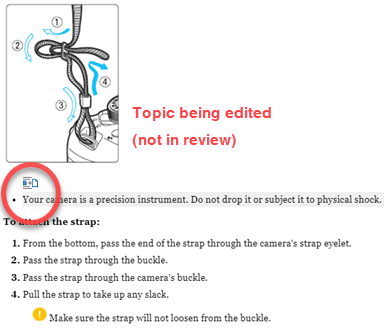
- The icon that you use to open the topic with the reference (
 ) is not available in a review.
) is not available in a review.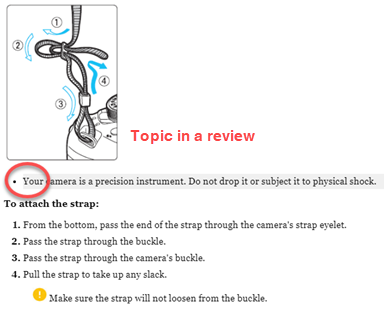
- The referenced content is shown with a grey background.
- You can't comment on the referenced content.
Understand profile filtering in a review
Authors can change the appearance of text in a component to show or hide content that they mark as conditional.
- Authors identify conditional text by adding profiling attributes.
- This lets them produce more than one version of a document when the versions differ in minor ways.
- For example, if one component contains content for both a repair technician and student, the author can apply different profiling attributes to the content for the different audiences. Then, if a reviewer only needs to see the repair tech content, the student content can be hidden using a filter for profiling attributes.
When you open a review, you may see:
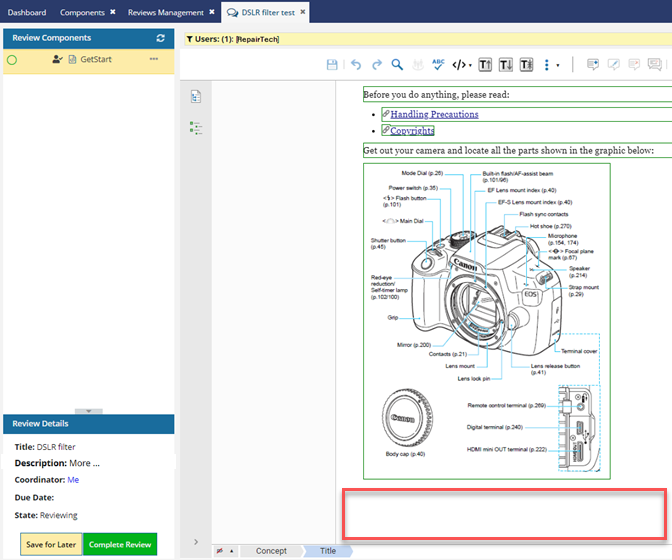
- A yellow banner at the top of the screen.

- Blank spaces. This is where content is not being shown because it didn't have the profiling attribute applied that the review coordinator specified.
This tells you:
- An author has identified conditional text using profiling attributes.
- A review coordinator has filtered the component's content to show you text that matches specific profiling attributes.
- In the yellow banner, you see:
- The name of the group of profiling attributes in bold. In the graphic above, this is Users.
- The name of the specific profiling attribute in square brackets. In the graphic above, this is [Repair Tech].
 Any text that does not have profiling attributes applied is always shown to reviewers.
Any text that does not have profiling attributes applied is always shown to reviewers.
If you don't want to see profiling attribute details in your review:
- Above the editor toolbar, in the informational bar, click
 the close icon.
the close icon.
Chat with the other reviewers
To find out who else is reviewing a component, look in the Collaboration pane.
- You can see if a reviewer has completed their review.
- You can send a reviewer an email
- You can use the Action menu to send them a notification in Inspire.
You can also start a discussion with all reviewers at once using the Discussions pane.
- You can continue a discussion no matter what state the review is in.
- Discussions are limited to 2000 characters, but you can create another one to keep the discussion going.
Inspire now supports concurrent editing so multiple Inspire users can edit the same component at the same time. This is useful when you need to have multiple team members complete a review simultaneously. For more information, read Share an editing session.
Add map topics to a review
Now you can add topics to a review if they are in a map but not in the review.
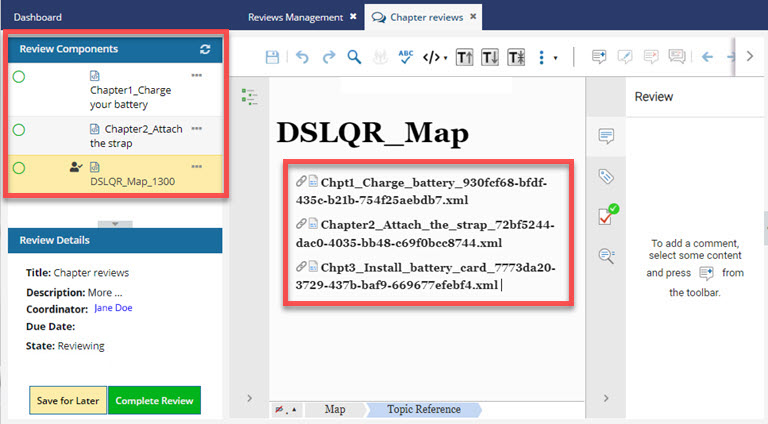
In the example image above:
- A topic in the map called Chpt3_Install_battery_card is in the map that's being reviewed
- The Chpt3_Install_battery_card topic is not in the list of Review Components, which means it isn't included in the review.
If you're reviewing a map component, and you identify changes that need to be made in referenced component:
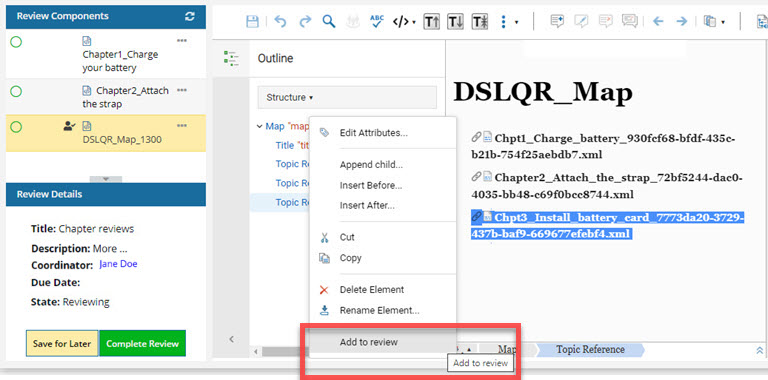
- You can add that component to the review and make changes, even if you aren't a review coordinator or administrator.
- You must be added to both of the following Collaborative Review module properties:
can_add_component_to_review
can_add_component_to_review_from_map
- The review must be in a State of Reviewing.
- The map containing the component must be included in the review.
- If review locks are configured, after you add the component to the review it is locked and included in the review.
For steps on adding a map component to a review, read Add map topics to a review.

 If you want to allow a non-administrator user to add a component to the review by editing the review Details:
If you want to allow a non-administrator user to add a component to the review by editing the review Details:
- The user only needs the following Collaborative Review module property: can_add_component_to_review.
- For more help, Admins can read Allow users to add a component to a review.
- Reviewers can read: Add a component to a review.
Complete an assignment
Completing a review assignment means you have referenced, commented on, or edited all topics in the Review Components list and selected the Complete Review button.
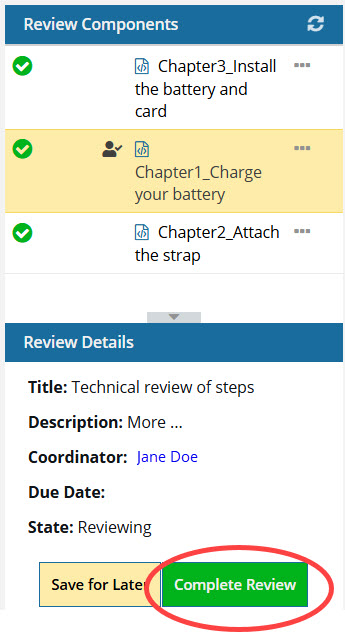
If you do any of the following, you haven't completed your review yet:
- Only review one component and save your changes.
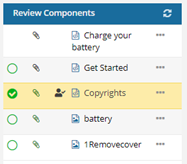
- Review a few or all components and select Save for Later.
- Review all components, select the green circle in the list, and close the review tab or Inspire without selecting the Complete Review button.
 After you complete your review:
After you complete your review:
- Your review is locked and you cannot make any other changes.
- The Review Coordinator receives a message that you've completed your review.
- On your Dashboard, in My Reviews, the completed review is no longer listed.
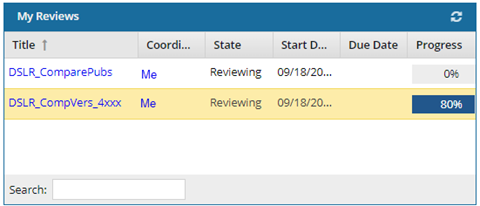
 If you want to re-open your review to make additional changes:
If you want to re-open your review to make additional changes:
- At least one other reviewer must still be working on their review.
To find out who else is reviewing components:
- Open the review from your email notification.
- On the right side, open the Collaboration panel.
- Look in the Reviewers list.
You can see if a reviewer still has a review in progress (Reviewing).
- Ask the Review Coordinator or an administrator to re-open your review.
- To send email to the review Coordinator:
- Open the review from your email notification.
- Go to the left side panel.
- Look in the Review Details panel.
- Click on the name following the Coordinator label.
- In the email form that opens, fill out the fields to request that your Completed review be re-opened (the fields will vary depending on your email app).
- In the email form, click Send.
- To send email to the review Coordinator:

Receive notifications
- Reviewers with Notifications enabled receive an email notification when a review is created, updated, and cancelled.
- When you complete a task that triggers a notification, such as importing content, the Slack and email message bodies contain:
- The notification with ten or less Issues, Errors, and Warnings.
- A link at the bottom of the message [See Full Version].
- You can click the [See Full Version] link to expand a section under the link with the full detail